BSBMGT608: Managing Innovation and Continuous Improvement Report
VerifiedAdded on 2024/06/07
|39
|5637
|133
Report
AI Summary
This report provides a comprehensive solution to the BSBMGT608 assignment, focusing on managing innovation and continuous improvement. It covers various quality management theories, Kotter's 8-step change model, diffusion of innovation, ISO 9000 standards, and cost-benefit analysis. The report also discusses learning organizations, shared vision, team learning, sustainability practices, and risk management according to AS/NZS ISO 31000:2009. Furthermore, it addresses practical aspects such as preparing a report on areas for improvement for Woodhouse Recruitment, developing action plans, analyzing survey results, and making recommendations for future customer surveys, providing a complete overview of the assignment's requirements.
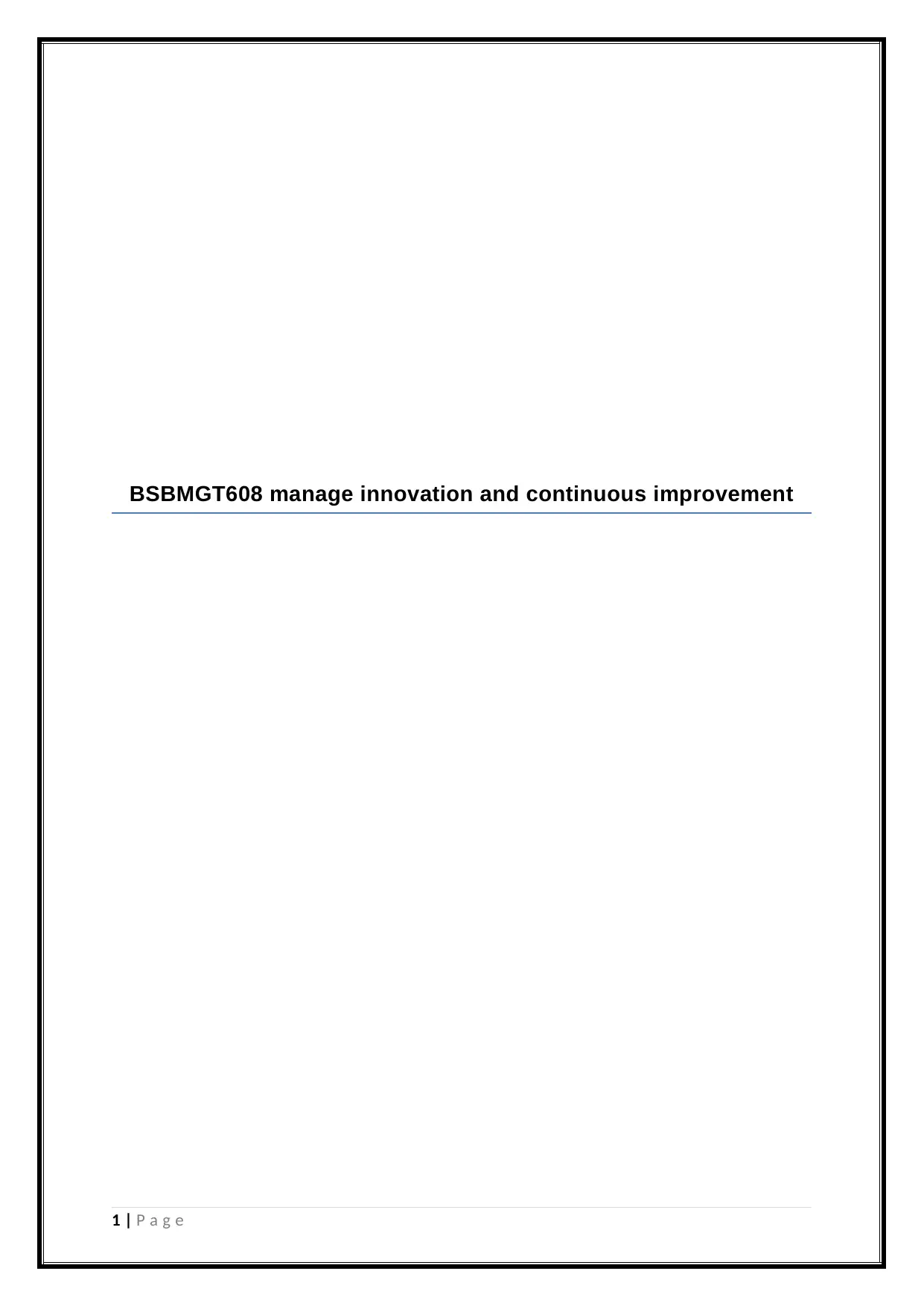
BSBMGT608 manage innovation and continuous improvement
1 | P a g e
1 | P a g e
Paraphrase This Document
Need a fresh take? Get an instant paraphrase of this document with our AI Paraphraser
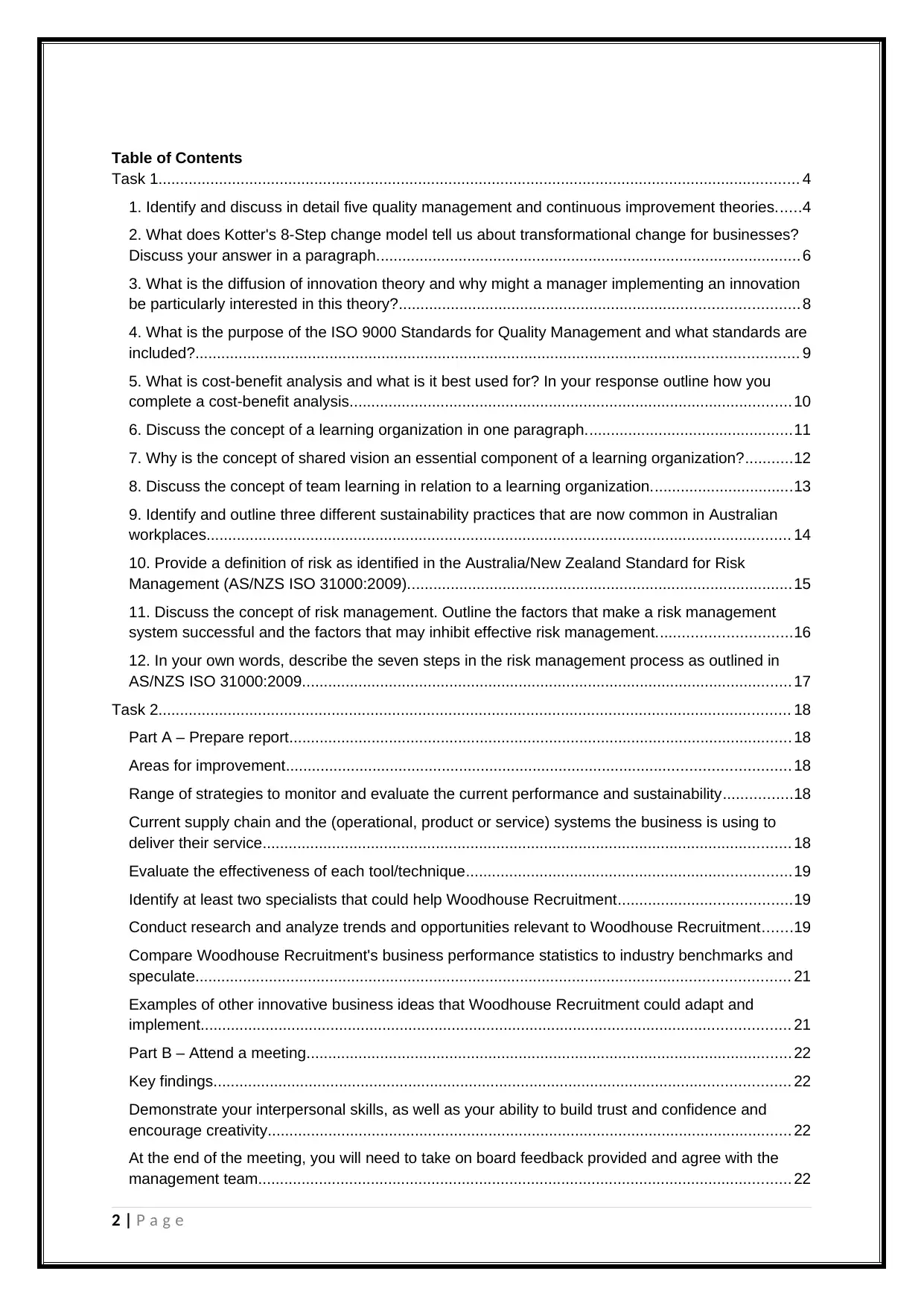
Table of Contents
Task 1.................................................................................................................................................... 4
1. Identify and discuss in detail five quality management and continuous improvement theories......4
2. What does Kotter's 8-Step change model tell us about transformational change for businesses?
Discuss your answer in a paragraph.................................................................................................. 6
3. What is the diffusion of innovation theory and why might a manager implementing an innovation
be particularly interested in this theory?............................................................................................ 8
4. What is the purpose of the ISO 9000 Standards for Quality Management and what standards are
included?........................................................................................................................................... 9
5. What is cost-benefit analysis and what is it best used for? In your response outline how you
complete a cost-benefit analysis...................................................................................................... 10
6. Discuss the concept of a learning organization in one paragraph................................................11
7. Why is the concept of shared vision an essential component of a learning organization?...........12
8. Discuss the concept of team learning in relation to a learning organization.................................13
9. Identify and outline three different sustainability practices that are now common in Australian
workplaces....................................................................................................................................... 14
10. Provide a definition of risk as identified in the Australia/New Zealand Standard for Risk
Management (AS/NZS ISO 31000:2009).........................................................................................15
11. Discuss the concept of risk management. Outline the factors that make a risk management
system successful and the factors that may inhibit effective risk management...............................16
12. In your own words, describe the seven steps in the risk management process as outlined in
AS/NZS ISO 31000:2009................................................................................................................. 17
Task 2.................................................................................................................................................. 18
Part A – Prepare report.................................................................................................................... 18
Areas for improvement.................................................................................................................... 18
Range of strategies to monitor and evaluate the current performance and sustainability................18
Current supply chain and the (operational, product or service) systems the business is using to
deliver their service.......................................................................................................................... 18
Evaluate the effectiveness of each tool/technique...........................................................................19
Identify at least two specialists that could help Woodhouse Recruitment........................................19
Conduct research and analyze trends and opportunities relevant to Woodhouse Recruitment.......19
Compare Woodhouse Recruitment's business performance statistics to industry benchmarks and
speculate......................................................................................................................................... 21
Examples of other innovative business ideas that Woodhouse Recruitment could adapt and
implement........................................................................................................................................ 21
Part B – Attend a meeting................................................................................................................ 22
Key findings..................................................................................................................................... 22
Demonstrate your interpersonal skills, as well as your ability to build trust and confidence and
encourage creativity......................................................................................................................... 22
At the end of the meeting, you will need to take on board feedback provided and agree with the
management team........................................................................................................................... 22
2 | P a g e
Task 1.................................................................................................................................................... 4
1. Identify and discuss in detail five quality management and continuous improvement theories......4
2. What does Kotter's 8-Step change model tell us about transformational change for businesses?
Discuss your answer in a paragraph.................................................................................................. 6
3. What is the diffusion of innovation theory and why might a manager implementing an innovation
be particularly interested in this theory?............................................................................................ 8
4. What is the purpose of the ISO 9000 Standards for Quality Management and what standards are
included?........................................................................................................................................... 9
5. What is cost-benefit analysis and what is it best used for? In your response outline how you
complete a cost-benefit analysis...................................................................................................... 10
6. Discuss the concept of a learning organization in one paragraph................................................11
7. Why is the concept of shared vision an essential component of a learning organization?...........12
8. Discuss the concept of team learning in relation to a learning organization.................................13
9. Identify and outline three different sustainability practices that are now common in Australian
workplaces....................................................................................................................................... 14
10. Provide a definition of risk as identified in the Australia/New Zealand Standard for Risk
Management (AS/NZS ISO 31000:2009).........................................................................................15
11. Discuss the concept of risk management. Outline the factors that make a risk management
system successful and the factors that may inhibit effective risk management...............................16
12. In your own words, describe the seven steps in the risk management process as outlined in
AS/NZS ISO 31000:2009................................................................................................................. 17
Task 2.................................................................................................................................................. 18
Part A – Prepare report.................................................................................................................... 18
Areas for improvement.................................................................................................................... 18
Range of strategies to monitor and evaluate the current performance and sustainability................18
Current supply chain and the (operational, product or service) systems the business is using to
deliver their service.......................................................................................................................... 18
Evaluate the effectiveness of each tool/technique...........................................................................19
Identify at least two specialists that could help Woodhouse Recruitment........................................19
Conduct research and analyze trends and opportunities relevant to Woodhouse Recruitment.......19
Compare Woodhouse Recruitment's business performance statistics to industry benchmarks and
speculate......................................................................................................................................... 21
Examples of other innovative business ideas that Woodhouse Recruitment could adapt and
implement........................................................................................................................................ 21
Part B – Attend a meeting................................................................................................................ 22
Key findings..................................................................................................................................... 22
Demonstrate your interpersonal skills, as well as your ability to build trust and confidence and
encourage creativity......................................................................................................................... 22
At the end of the meeting, you will need to take on board feedback provided and agree with the
management team........................................................................................................................... 22
2 | P a g e
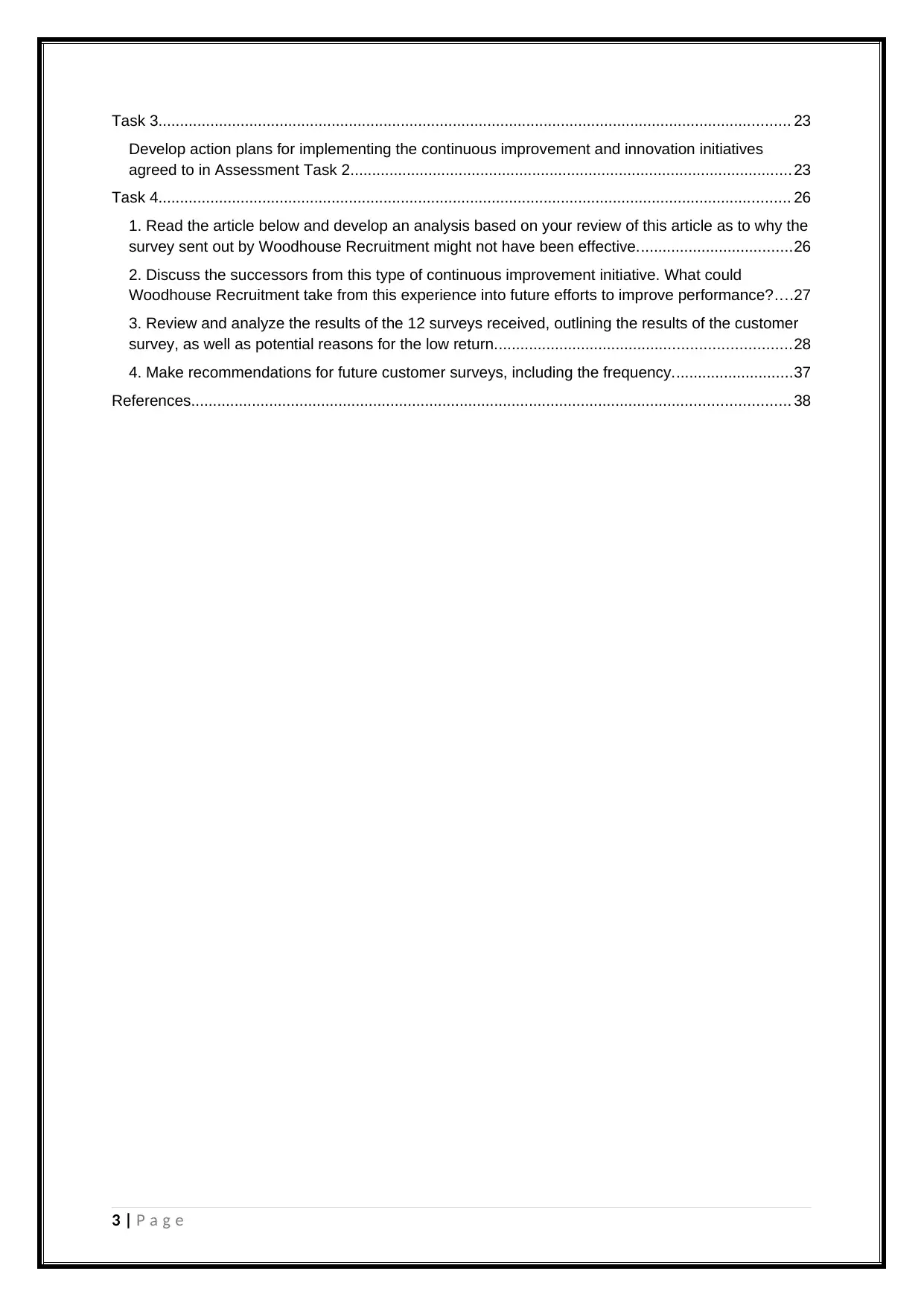
Task 3.................................................................................................................................................. 23
Develop action plans for implementing the continuous improvement and innovation initiatives
agreed to in Assessment Task 2...................................................................................................... 23
Task 4.................................................................................................................................................. 26
1. Read the article below and develop an analysis based on your review of this article as to why the
survey sent out by Woodhouse Recruitment might not have been effective....................................26
2. Discuss the successors from this type of continuous improvement initiative. What could
Woodhouse Recruitment take from this experience into future efforts to improve performance?....27
3. Review and analyze the results of the 12 surveys received, outlining the results of the customer
survey, as well as potential reasons for the low return....................................................................28
4. Make recommendations for future customer surveys, including the frequency............................37
References.......................................................................................................................................... 38
3 | P a g e
Develop action plans for implementing the continuous improvement and innovation initiatives
agreed to in Assessment Task 2...................................................................................................... 23
Task 4.................................................................................................................................................. 26
1. Read the article below and develop an analysis based on your review of this article as to why the
survey sent out by Woodhouse Recruitment might not have been effective....................................26
2. Discuss the successors from this type of continuous improvement initiative. What could
Woodhouse Recruitment take from this experience into future efforts to improve performance?....27
3. Review and analyze the results of the 12 surveys received, outlining the results of the customer
survey, as well as potential reasons for the low return....................................................................28
4. Make recommendations for future customer surveys, including the frequency............................37
References.......................................................................................................................................... 38
3 | P a g e
⊘ This is a preview!⊘
Do you want full access?
Subscribe today to unlock all pages.

Trusted by 1+ million students worldwide
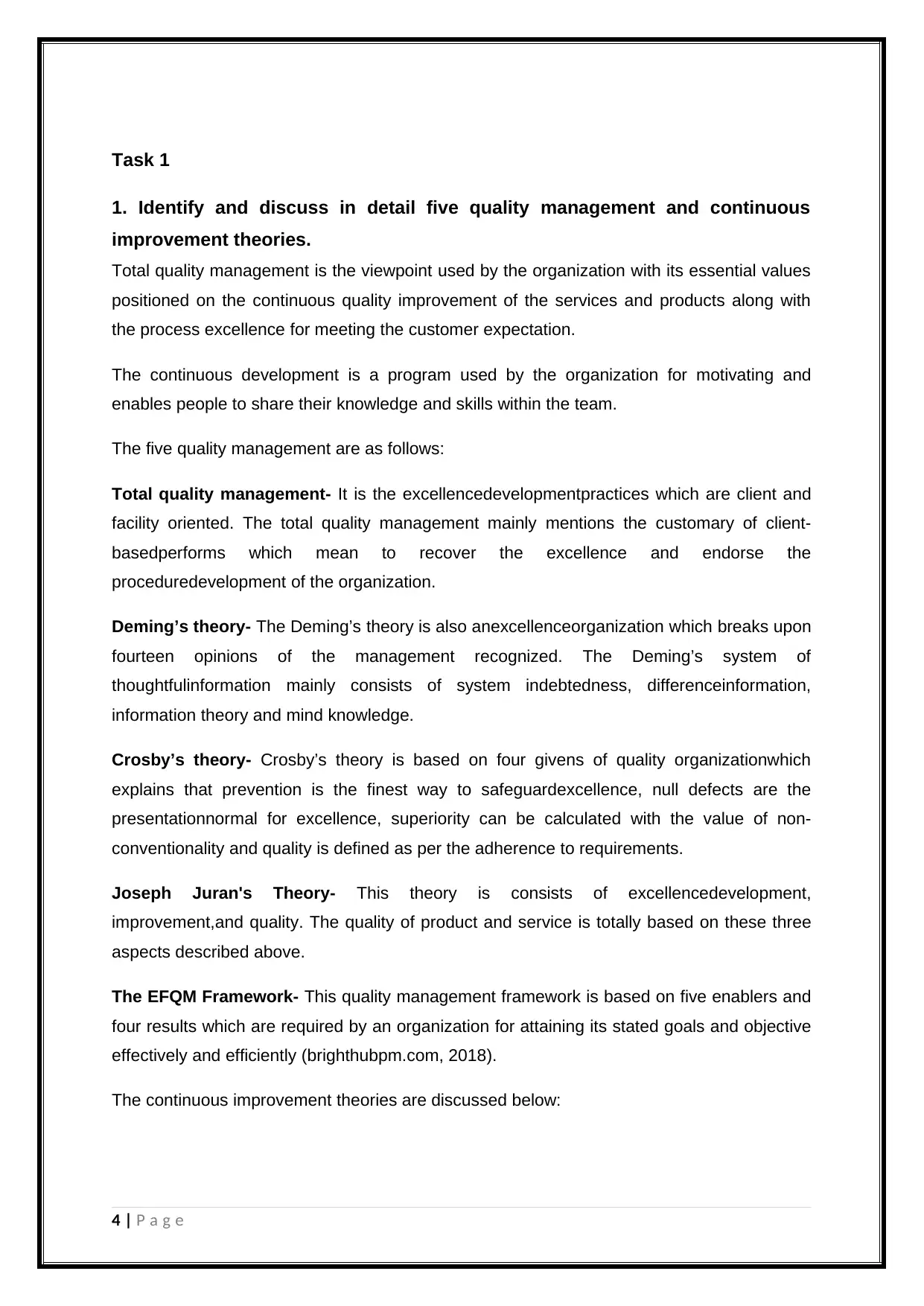
Task 1
1. Identify and discuss in detail five quality management and continuous
improvement theories.
Total quality management is the viewpoint used by the organization with its essential values
positioned on the continuous quality improvement of the services and products along with
the process excellence for meeting the customer expectation.
The continuous development is a program used by the organization for motivating and
enables people to share their knowledge and skills within the team.
The five quality management are as follows:
Total quality management- It is the excellencedevelopmentpractices which are client and
facility oriented. The total quality management mainly mentions the customary of client-
basedperforms which mean to recover the excellence and endorse the
proceduredevelopment of the organization.
Deming’s theory- The Deming’s theory is also anexcellenceorganization which breaks upon
fourteen opinions of the management recognized. The Deming’s system of
thoughtfulinformation mainly consists of system indebtedness, differenceinformation,
information theory and mind knowledge.
Crosby’s theory- Crosby’s theory is based on four givens of quality organizationwhich
explains that prevention is the finest way to safeguardexcellence, null defects are the
presentationnormal for excellence, superiority can be calculated with the value of non-
conventionality and quality is defined as per the adherence to requirements.
Joseph Juran's Theory- This theory is consists of excellencedevelopment,
improvement,and quality. The quality of product and service is totally based on these three
aspects described above.
The EFQM Framework- This quality management framework is based on five enablers and
four results which are required by an organization for attaining its stated goals and objective
effectively and efficiently (brighthubpm.com, 2018).
The continuous improvement theories are discussed below:
4 | P a g e
1. Identify and discuss in detail five quality management and continuous
improvement theories.
Total quality management is the viewpoint used by the organization with its essential values
positioned on the continuous quality improvement of the services and products along with
the process excellence for meeting the customer expectation.
The continuous development is a program used by the organization for motivating and
enables people to share their knowledge and skills within the team.
The five quality management are as follows:
Total quality management- It is the excellencedevelopmentpractices which are client and
facility oriented. The total quality management mainly mentions the customary of client-
basedperforms which mean to recover the excellence and endorse the
proceduredevelopment of the organization.
Deming’s theory- The Deming’s theory is also anexcellenceorganization which breaks upon
fourteen opinions of the management recognized. The Deming’s system of
thoughtfulinformation mainly consists of system indebtedness, differenceinformation,
information theory and mind knowledge.
Crosby’s theory- Crosby’s theory is based on four givens of quality organizationwhich
explains that prevention is the finest way to safeguardexcellence, null defects are the
presentationnormal for excellence, superiority can be calculated with the value of non-
conventionality and quality is defined as per the adherence to requirements.
Joseph Juran's Theory- This theory is consists of excellencedevelopment,
improvement,and quality. The quality of product and service is totally based on these three
aspects described above.
The EFQM Framework- This quality management framework is based on five enablers and
four results which are required by an organization for attaining its stated goals and objective
effectively and efficiently (brighthubpm.com, 2018).
The continuous improvement theories are discussed below:
4 | P a g e
Paraphrase This Document
Need a fresh take? Get an instant paraphrase of this document with our AI Paraphraser
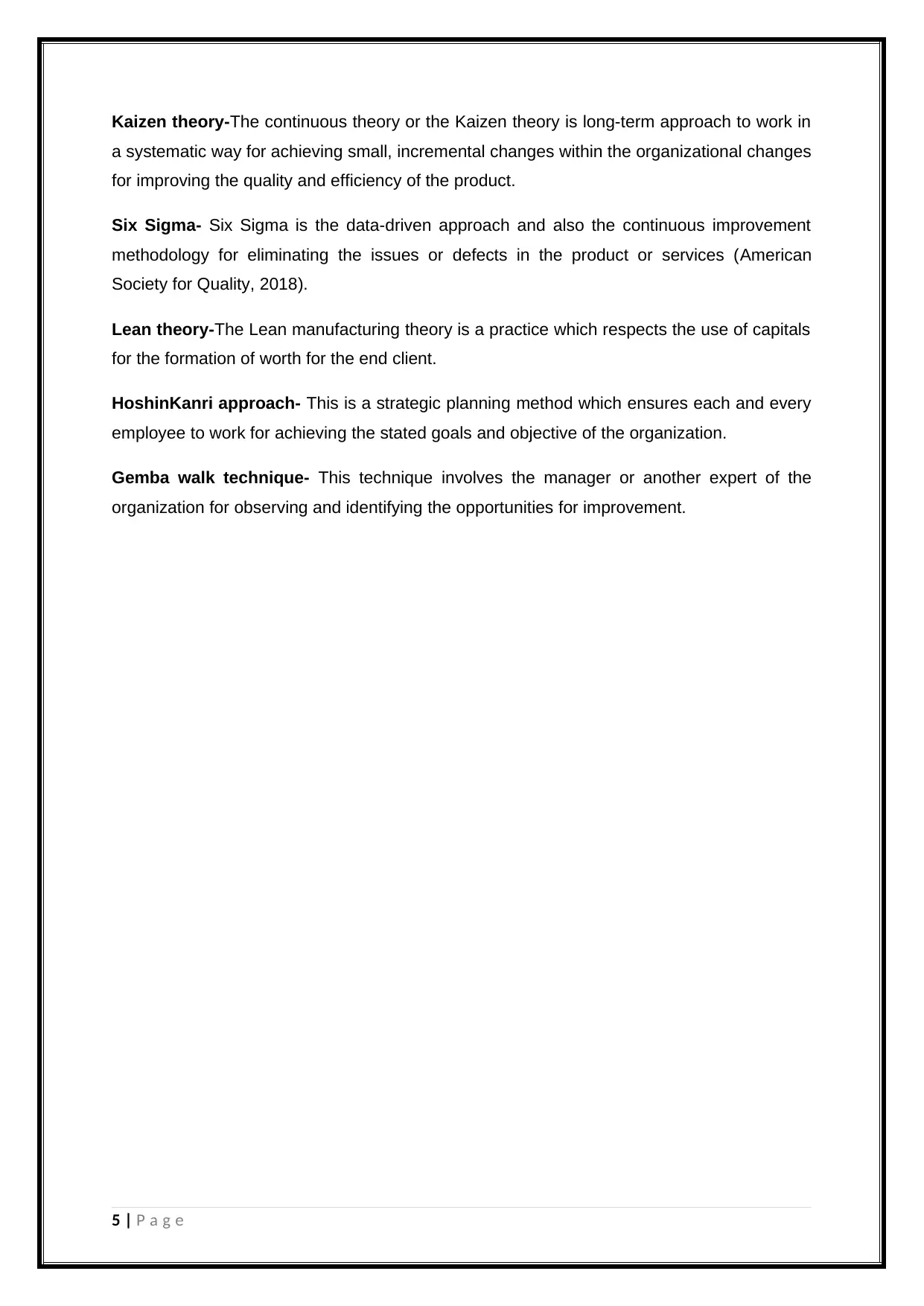
Kaizen theory-The continuous theory or the Kaizen theory is long-term approach to work in
a systematic way for achieving small, incremental changes within the organizational changes
for improving the quality and efficiency of the product.
Six Sigma- Six Sigma is the data-driven approach and also the continuous improvement
methodology for eliminating the issues or defects in the product or services (American
Society for Quality, 2018).
Lean theory-The Lean manufacturing theory is a practice which respects the use of capitals
for the formation of worth for the end client.
HoshinKanri approach- This is a strategic planning method which ensures each and every
employee to work for achieving the stated goals and objective of the organization.
Gemba walk technique- This technique involves the manager or another expert of the
organization for observing and identifying the opportunities for improvement.
5 | P a g e
a systematic way for achieving small, incremental changes within the organizational changes
for improving the quality and efficiency of the product.
Six Sigma- Six Sigma is the data-driven approach and also the continuous improvement
methodology for eliminating the issues or defects in the product or services (American
Society for Quality, 2018).
Lean theory-The Lean manufacturing theory is a practice which respects the use of capitals
for the formation of worth for the end client.
HoshinKanri approach- This is a strategic planning method which ensures each and every
employee to work for achieving the stated goals and objective of the organization.
Gemba walk technique- This technique involves the manager or another expert of the
organization for observing and identifying the opportunities for improvement.
5 | P a g e
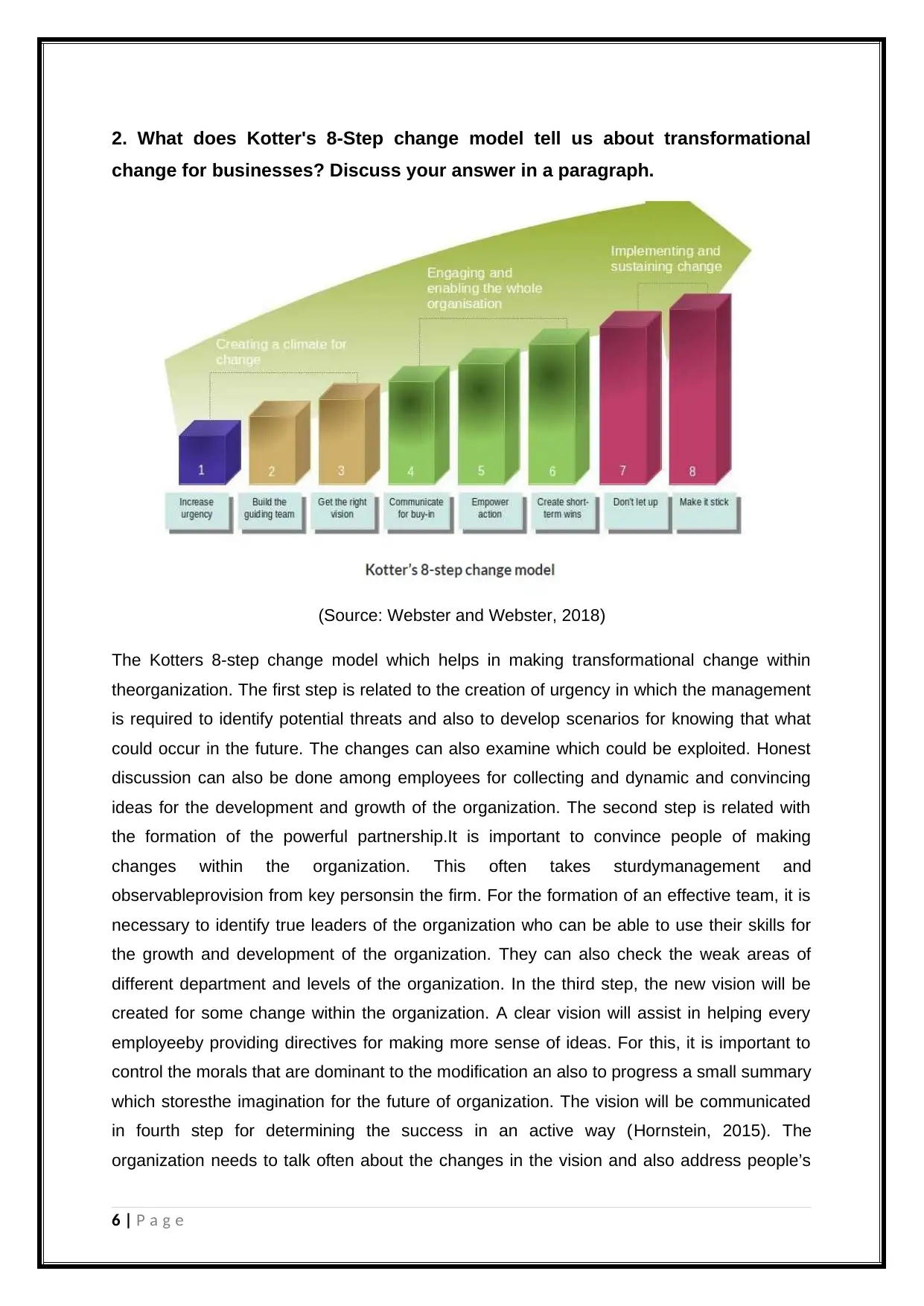
2. What does Kotter's 8-Step change model tell us about transformational
change for businesses? Discuss your answer in a paragraph.
(Source: Webster and Webster, 2018)
The Kotters 8-step change model which helps in making transformational change within
theorganization. The first step is related to the creation of urgency in which the management
is required to identify potential threats and also to develop scenarios for knowing that what
could occur in the future. The changes can also examine which could be exploited. Honest
discussion can also be done among employees for collecting and dynamic and convincing
ideas for the development and growth of the organization. The second step is related with
the formation of the powerful partnership.It is important to convince people of making
changes within the organization. This often takes sturdymanagement and
observableprovision from key personsin the firm. For the formation of an effective team, it is
necessary to identify true leaders of the organization who can be able to use their skills for
the growth and development of the organization. They can also check the weak areas of
different department and levels of the organization. In the third step, the new vision will be
created for some change within the organization. A clear vision will assist in helping every
employeeby providing directives for making more sense of ideas. For this, it is important to
control the morals that are dominant to the modification an also to progress a small summary
which storesthe imagination for the future of organization. The vision will be communicated
in fourth step for determining the success in an active way (Hornstein, 2015). The
organization needs to talk often about the changes in the vision and also address people’s
6 | P a g e
change for businesses? Discuss your answer in a paragraph.
(Source: Webster and Webster, 2018)
The Kotters 8-step change model which helps in making transformational change within
theorganization. The first step is related to the creation of urgency in which the management
is required to identify potential threats and also to develop scenarios for knowing that what
could occur in the future. The changes can also examine which could be exploited. Honest
discussion can also be done among employees for collecting and dynamic and convincing
ideas for the development and growth of the organization. The second step is related with
the formation of the powerful partnership.It is important to convince people of making
changes within the organization. This often takes sturdymanagement and
observableprovision from key personsin the firm. For the formation of an effective team, it is
necessary to identify true leaders of the organization who can be able to use their skills for
the growth and development of the organization. They can also check the weak areas of
different department and levels of the organization. In the third step, the new vision will be
created for some change within the organization. A clear vision will assist in helping every
employeeby providing directives for making more sense of ideas. For this, it is important to
control the morals that are dominant to the modification an also to progress a small summary
which storesthe imagination for the future of organization. The vision will be communicated
in fourth step for determining the success in an active way (Hornstein, 2015). The
organization needs to talk often about the changes in the vision and also address people’s
6 | P a g e
⊘ This is a preview!⊘
Do you want full access?
Subscribe today to unlock all pages.

Trusted by 1+ million students worldwide
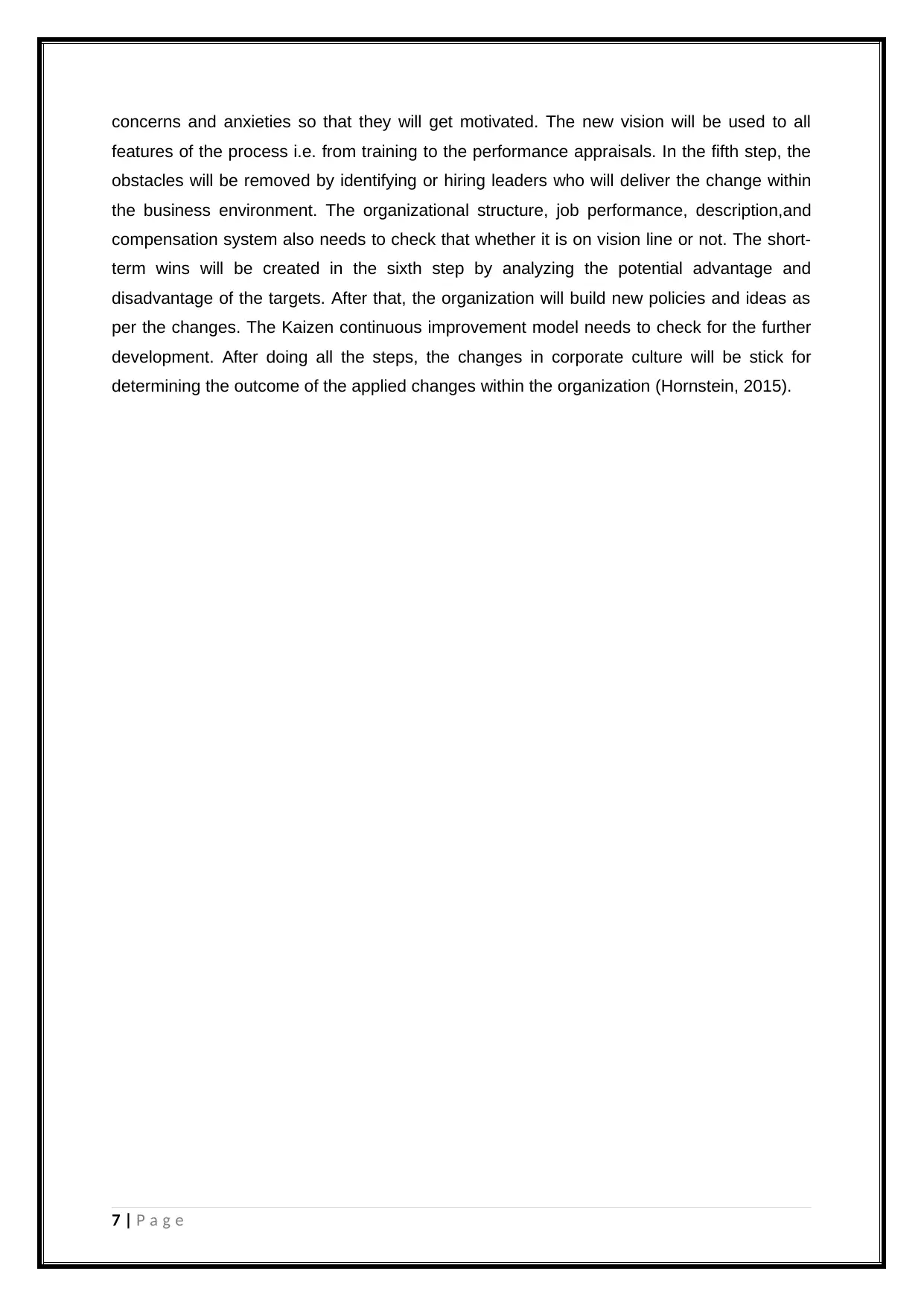
concerns and anxieties so that they will get motivated. The new vision will be used to all
features of the process i.e. from training to the performance appraisals. In the fifth step, the
obstacles will be removed by identifying or hiring leaders who will deliver the change within
the business environment. The organizational structure, job performance, description,and
compensation system also needs to check that whether it is on vision line or not. The short-
term wins will be created in the sixth step by analyzing the potential advantage and
disadvantage of the targets. After that, the organization will build new policies and ideas as
per the changes. The Kaizen continuous improvement model needs to check for the further
development. After doing all the steps, the changes in corporate culture will be stick for
determining the outcome of the applied changes within the organization (Hornstein, 2015).
7 | P a g e
features of the process i.e. from training to the performance appraisals. In the fifth step, the
obstacles will be removed by identifying or hiring leaders who will deliver the change within
the business environment. The organizational structure, job performance, description,and
compensation system also needs to check that whether it is on vision line or not. The short-
term wins will be created in the sixth step by analyzing the potential advantage and
disadvantage of the targets. After that, the organization will build new policies and ideas as
per the changes. The Kaizen continuous improvement model needs to check for the further
development. After doing all the steps, the changes in corporate culture will be stick for
determining the outcome of the applied changes within the organization (Hornstein, 2015).
7 | P a g e
Paraphrase This Document
Need a fresh take? Get an instant paraphrase of this document with our AI Paraphraser
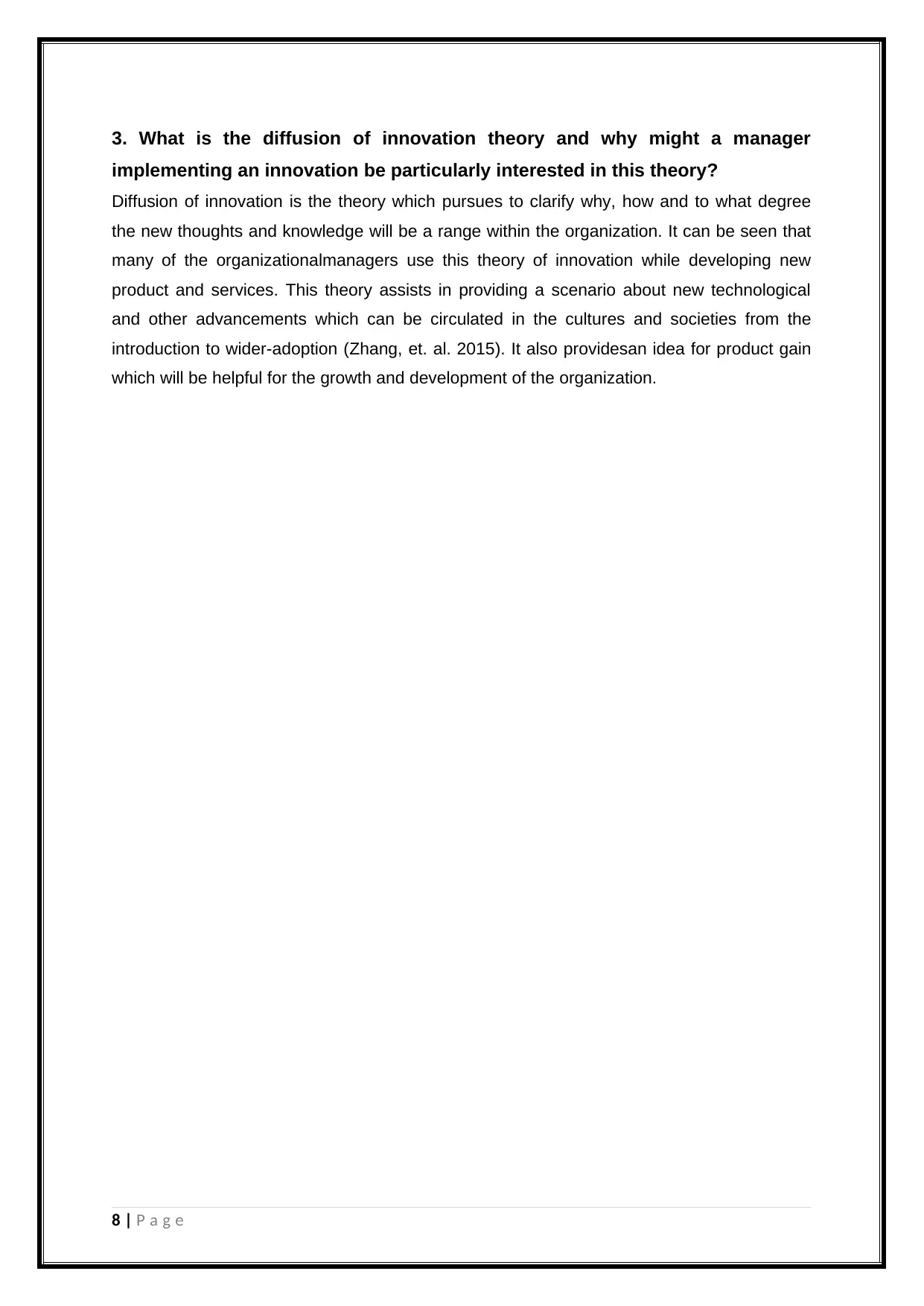
3. What is the diffusion of innovation theory and why might a manager
implementing an innovation be particularly interested in this theory?
Diffusion of innovation is the theory which pursues to clarify why, how and to what degree
the new thoughts and knowledge will be a range within the organization. It can be seen that
many of the organizationalmanagers use this theory of innovation while developing new
product and services. This theory assists in providing a scenario about new technological
and other advancements which can be circulated in the cultures and societies from the
introduction to wider-adoption (Zhang, et. al. 2015). It also providesan idea for product gain
which will be helpful for the growth and development of the organization.
8 | P a g e
implementing an innovation be particularly interested in this theory?
Diffusion of innovation is the theory which pursues to clarify why, how and to what degree
the new thoughts and knowledge will be a range within the organization. It can be seen that
many of the organizationalmanagers use this theory of innovation while developing new
product and services. This theory assists in providing a scenario about new technological
and other advancements which can be circulated in the cultures and societies from the
introduction to wider-adoption (Zhang, et. al. 2015). It also providesan idea for product gain
which will be helpful for the growth and development of the organization.
8 | P a g e
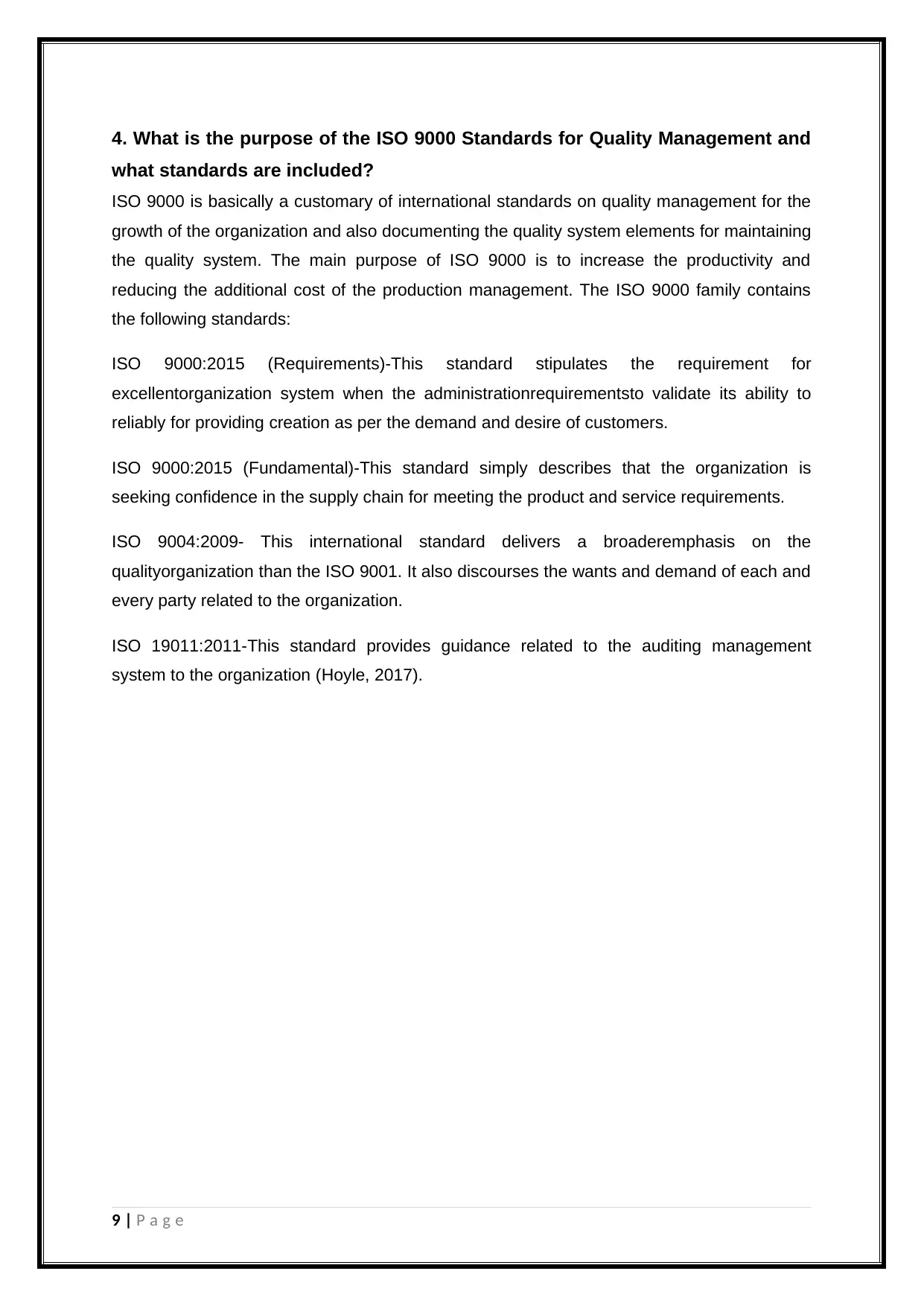
4. What is the purpose of the ISO 9000 Standards for Quality Management and
what standards are included?
ISO 9000 is basically a customary of international standards on quality management for the
growth of the organization and also documenting the quality system elements for maintaining
the quality system. The main purpose of ISO 9000 is to increase the productivity and
reducing the additional cost of the production management. The ISO 9000 family contains
the following standards:
ISO 9000:2015 (Requirements)-This standard stipulates the requirement for
excellentorganization system when the administrationrequirementsto validate its ability to
reliably for providing creation as per the demand and desire of customers.
ISO 9000:2015 (Fundamental)-This standard simply describes that the organization is
seeking confidence in the supply chain for meeting the product and service requirements.
ISO 9004:2009- This international standard delivers a broaderemphasis on the
qualityorganization than the ISO 9001. It also discourses the wants and demand of each and
every party related to the organization.
ISO 19011:2011-This standard provides guidance related to the auditing management
system to the organization (Hoyle, 2017).
9 | P a g e
what standards are included?
ISO 9000 is basically a customary of international standards on quality management for the
growth of the organization and also documenting the quality system elements for maintaining
the quality system. The main purpose of ISO 9000 is to increase the productivity and
reducing the additional cost of the production management. The ISO 9000 family contains
the following standards:
ISO 9000:2015 (Requirements)-This standard stipulates the requirement for
excellentorganization system when the administrationrequirementsto validate its ability to
reliably for providing creation as per the demand and desire of customers.
ISO 9000:2015 (Fundamental)-This standard simply describes that the organization is
seeking confidence in the supply chain for meeting the product and service requirements.
ISO 9004:2009- This international standard delivers a broaderemphasis on the
qualityorganization than the ISO 9001. It also discourses the wants and demand of each and
every party related to the organization.
ISO 19011:2011-This standard provides guidance related to the auditing management
system to the organization (Hoyle, 2017).
9 | P a g e
⊘ This is a preview!⊘
Do you want full access?
Subscribe today to unlock all pages.

Trusted by 1+ million students worldwide
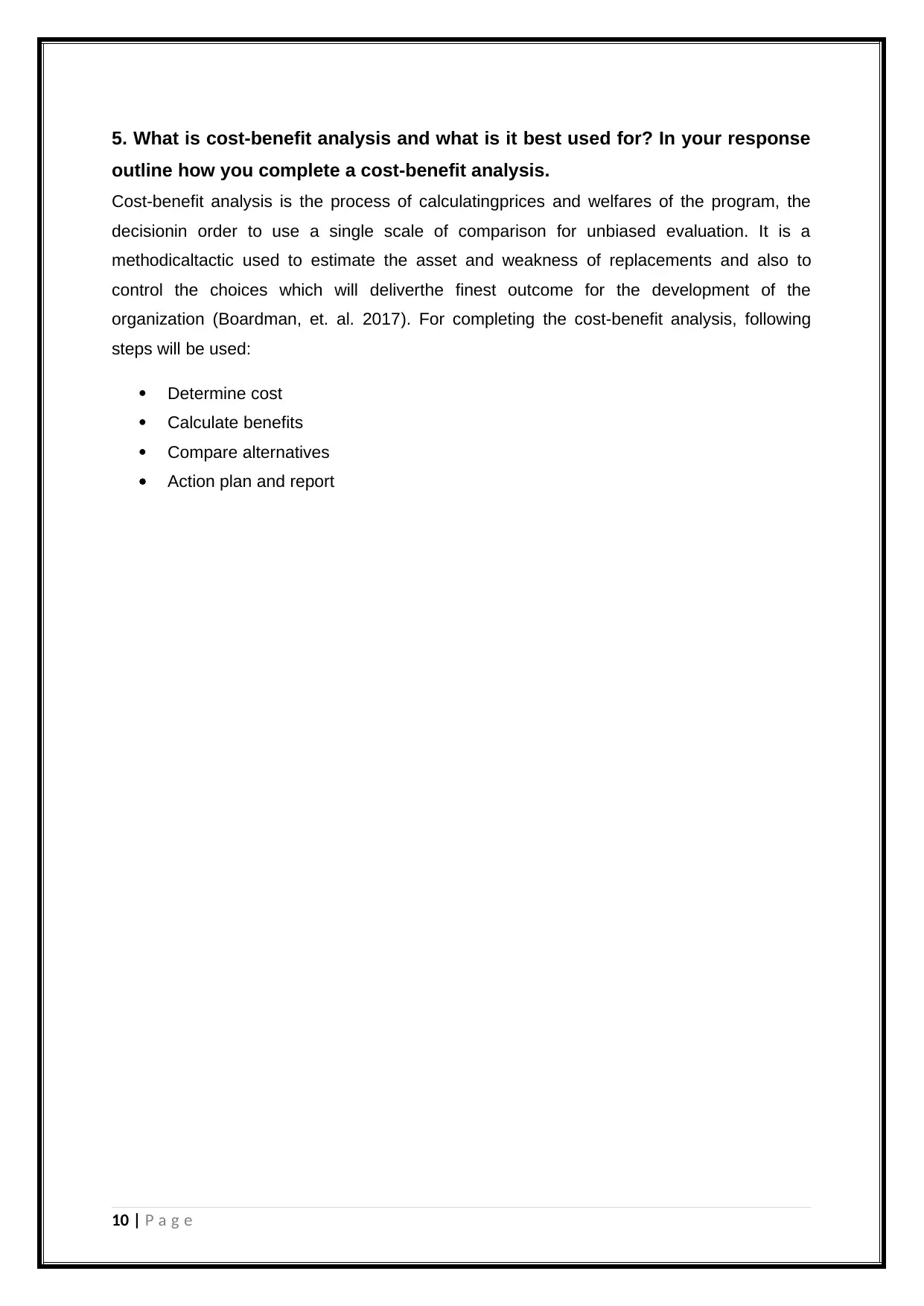
5. What is cost-benefit analysis and what is it best used for? In your response
outline how you complete a cost-benefit analysis.
Cost-benefit analysis is the process of calculatingprices and welfares of the program, the
decisionin order to use a single scale of comparison for unbiased evaluation. It is a
methodicaltactic used to estimate the asset and weakness of replacements and also to
control the choices which will deliverthe finest outcome for the development of the
organization (Boardman, et. al. 2017). For completing the cost-benefit analysis, following
steps will be used:
Determine cost
Calculate benefits
Compare alternatives
Action plan and report
10 | P a g e
outline how you complete a cost-benefit analysis.
Cost-benefit analysis is the process of calculatingprices and welfares of the program, the
decisionin order to use a single scale of comparison for unbiased evaluation. It is a
methodicaltactic used to estimate the asset and weakness of replacements and also to
control the choices which will deliverthe finest outcome for the development of the
organization (Boardman, et. al. 2017). For completing the cost-benefit analysis, following
steps will be used:
Determine cost
Calculate benefits
Compare alternatives
Action plan and report
10 | P a g e
Paraphrase This Document
Need a fresh take? Get an instant paraphrase of this document with our AI Paraphraser
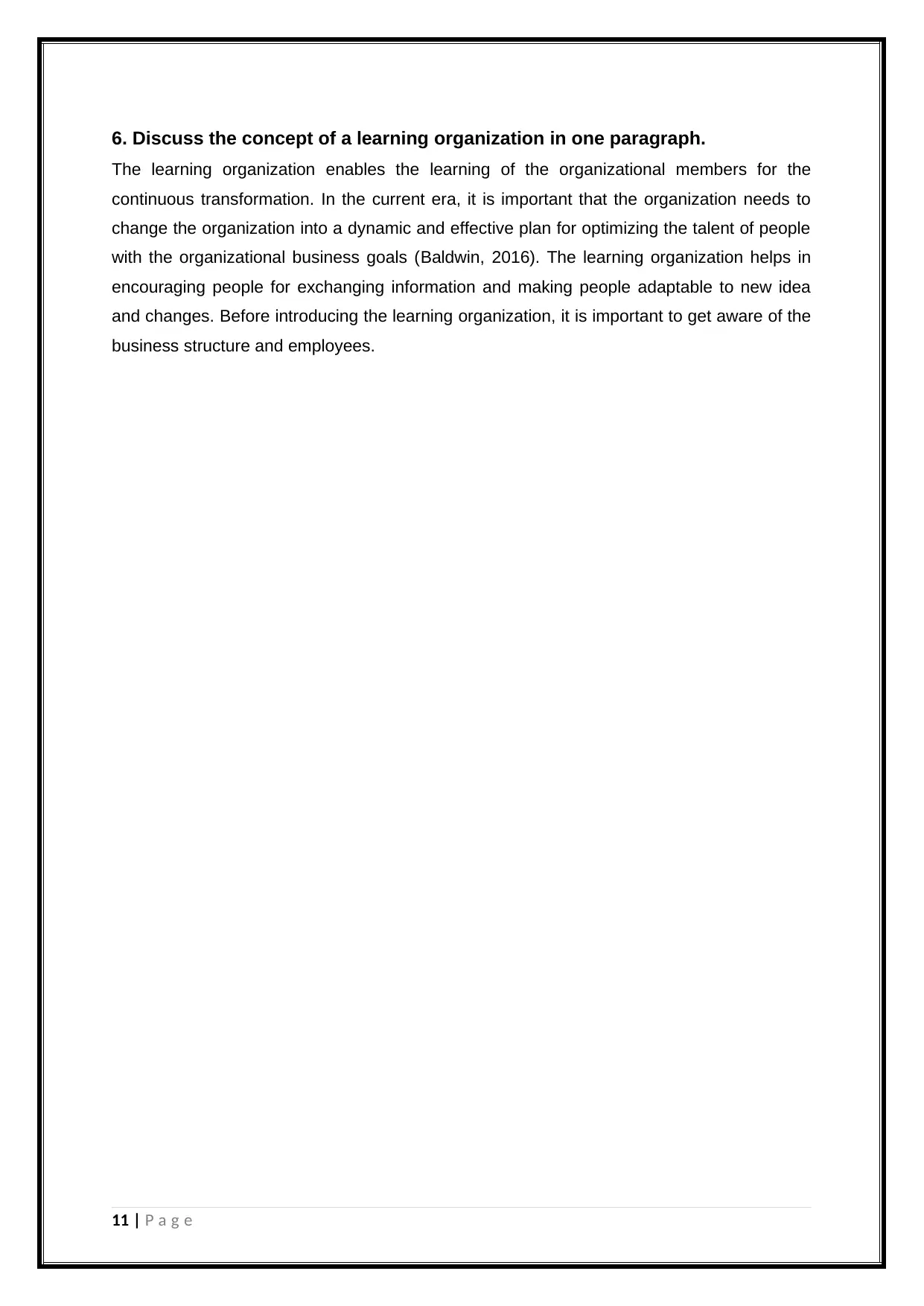
6. Discuss the concept of a learning organization in one paragraph.
The learning organization enables the learning of the organizational members for the
continuous transformation. In the current era, it is important that the organization needs to
change the organization into a dynamic and effective plan for optimizing the talent of people
with the organizational business goals (Baldwin, 2016). The learning organization helps in
encouraging people for exchanging information and making people adaptable to new idea
and changes. Before introducing the learning organization, it is important to get aware of the
business structure and employees.
11 | P a g e
The learning organization enables the learning of the organizational members for the
continuous transformation. In the current era, it is important that the organization needs to
change the organization into a dynamic and effective plan for optimizing the talent of people
with the organizational business goals (Baldwin, 2016). The learning organization helps in
encouraging people for exchanging information and making people adaptable to new idea
and changes. Before introducing the learning organization, it is important to get aware of the
business structure and employees.
11 | P a g e

7. Why is the concept of shared vision an essential component of a learning
organization?
The communal vision is important for the building a successful learning organization. The
shared vision helps in providing energy and focus to the employees so that they can be able
to use their skills for the growth and development of the organization (Study.com, 2018). All
these factors empower the organization to learn and transform itself as required to
accomplish the shared vision of the business environment.
12 | P a g e
organization?
The communal vision is important for the building a successful learning organization. The
shared vision helps in providing energy and focus to the employees so that they can be able
to use their skills for the growth and development of the organization (Study.com, 2018). All
these factors empower the organization to learn and transform itself as required to
accomplish the shared vision of the business environment.
12 | P a g e
⊘ This is a preview!⊘
Do you want full access?
Subscribe today to unlock all pages.

Trusted by 1+ million students worldwide
1 out of 39
Related Documents
Your All-in-One AI-Powered Toolkit for Academic Success.
+13062052269
info@desklib.com
Available 24*7 on WhatsApp / Email
![[object Object]](/_next/static/media/star-bottom.7253800d.svg)
Unlock your academic potential
Copyright © 2020–2025 A2Z Services. All Rights Reserved. Developed and managed by ZUCOL.




